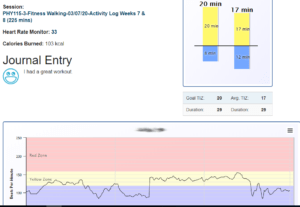By transitioning to online PE programs for students using the IHT ZONE wrist heart rate monitor, schools kept an important student-teacher connection when COVID-19 forced a switch from in-person to at-home learning.
“When we were shifted to distance learning, at least we had a system in place, so we simply modified it for the kids at home,” Fossil Ridge High School PE teacher Lisa McVicker said. “We still want students to document what they are doing based on the focus of the class for that week.”
McVicker’s students wear the IHT ZONE during their on-campus PE classes. The monitors collect heart rate data that makes up an essential part of the learning process. The monitors give both students and teachers an objective, data-based look at the student’s performance. The IHT ZONE gives students:
- their heart rate in real-time as they move through their workout,
- a post-session report with detailed heart rate information including time spent exercising in each heart rate zone, and
- an email to the teacher that provides them with information to deliver personalized feedback to each student.
“The evidence shows us what is really going on,” she said. “It helps us reaffirm that students really are doing what they need to do.”
Enhancing Online PE with Feedback and Accountability
In addition to the on-campus PE class, McVicker offers an online PE class that meets both during the school year and over the summer. Fossil Ridge has offered online PE for years, but McVicker and her colleagues recently overhauled the course.
“We wanted to build in accountability,” she said. “Before, parents just had to sign off that the student did the required exercise. We wanted to bring a real-world application model. We want to make it like the class students experience at school. That means they are doing evidence-based workouts.”
 For the online students to get the same evidence the on-campus students got, McVicker added more IHT ZONE monitors and configured them for students to use with their mobile devices. Through IHT’s mobile app, students access McVicker’s assignments, start their ZONE monitor and workout just like they do at school. During and after the workout, both student and teacher receive the same information.
For the online students to get the same evidence the on-campus students got, McVicker added more IHT ZONE monitors and configured them for students to use with their mobile devices. Through IHT’s mobile app, students access McVicker’s assignments, start their ZONE monitor and workout just like they do at school. During and after the workout, both student and teacher receive the same information.
“We knew we wanted to embrace technology and make it so the students could pick something that works for them,” McVicker said. “With the IHT App, it’s simple. You start it up, do your thing, stop it and there it is.”
Online Class Provides Path to Adult Exercise Realities
When the campus closed, McVicker simply started the summer online PE class. She distributed her IHT ZONE monitors and encouraged students to exercise as often as they could. Each student had a goal to exercise at a moderate to vigorous level for at least 180 minutes per week. McVicker allowed students to exercise when they could make time.
“Right now, we’re seeing the kids in the summer online program working out four or five times each week,” she said.
Students learned to navigate their jobs and other obligations. That can be stressful, but it gave the teacher an opportunity to help students develop life skills for the future.
“We have to learn to do the best we can with what we’ve got,” McVicker said. “This is real life. When can you fit in a workout? Students are developing workarounds and learning to be flexible.”
The mobile app also allows students ]to record their thoughts and feelings. As they stop and save their workout, they can choose from a series of emojis that quickly record how they feel. They can also add notes that summarize their thoughts. McVicker uses that feedback as a way to check in with students about how they are managing their emotions as well as their fitness.
“They get to reflect on how they feel when they work out, and most of them are being pretty honest about it,” McVicker said. “One recently said she wasn’t feeling up to it but had to make herself grind through it. This is as close to engaging with them to talk about the social and emotional health as we can get right now.”
As she sees more students succeed in the online class – logging workouts, meeting the weekly goal and staying active – McVicker gets more comfortable about the 2020-21 school year. If students aren’t going to be on campus, she knows her program can keep them active and focused on their physical and mental health.
“If we have to look at ways to do this when school starts again, knowing we can do this alleviates any anxiety I’ve got about how the PE program will look,” she said. “We have tools and ways for kids to work with the heart rate monitors online and document what they are doing and provide good feedback.”


